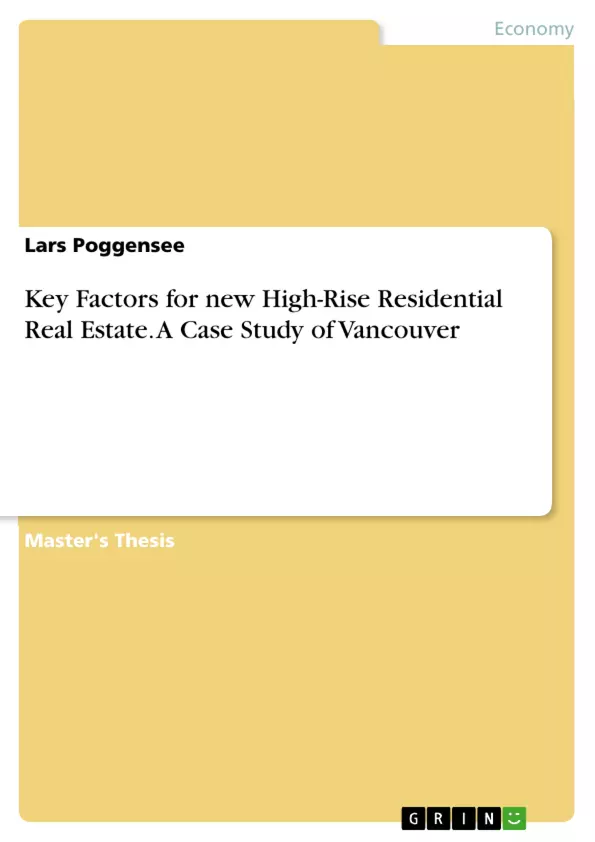This dissertation aims to evaluate the potential of high-rise residential real estate to provide affordable housing in urban areas as a response to the growing population. The city of Vancouver was selected as a case study. Beginning with an analysis of Vancouver’s housing market, three important factors that mainly influence success or failure of new high-rise residential real estate were identified and their validity reviewed. The results indicate that in order for high-rise residential real estate to be a part of the solution to overcome housing shortages, it must be supported by a clear set of policies and a framework that assures an adequate supply of affordable units. The needs of the local population need to be considered appropriately (suitability), and a certain level of liveability needs to be retained to avoid overcrowded or underused urban areas.
The populations of urban areas are expected to grow over the coming decades. Consequently, if demand exceeds supply, housing costs are likely to rise, and the portion of disposable income that needs to be spent on housing will rise.
Inhaltsverzeichnis (Table of Contents)
- 1. Introduction
- 1.1. Background
- 1.2. Research focus
- 1.3. Aims and objectives
- 1.4. Research overview
- 2. Literature Review
- 2.1. Introduction
- 2.2. The history of high-rise residential real estate
- 2.3. Distinction between high-rise and high-density
- 2.4. Economic factors of high-rise residential real estate
- 2.4.1. Construction costs: the correlation between construction costs and height
- 2.4.2. Maintenance and operational costs
- 2.5. Inadequate consideration for the needs of the local population
- 2.6. Liveability and Vancouverism
- 2.7. The role of government policies and regulations
- 2.8. Conclusion
- 3. Research Methodology
- 3.1. Introduction
- 3.2. Methodology
- 3.3. Data Analysis
- 3.4. Data Collection
- 4. Analysis
- 4.1. Introduction
- 4.2. City of Vancouver, British Columbia
- 4.2.1. Basic information
- 4.2.2. Demographics
- 4.2.3. Economy
- 4.2.4. The housing market of Vancouver
- 4.2.5. Housing Vancouver Strategy
- 4.2.6. Vancouver's building policies and regulations
- 4.3. Findings
- 4.3.1. Introduction
- 4.3.2. New housing constructions in Vancouver
- 4.3.3. Affordability
- 4.3.5. Suitability
- 4.3.5. Liveability
- 5. Conclusion
- 5.1. Summary of findings
- 5.2. Limitations
- 5.3. Recommendations
Zielsetzung und Themenschwerpunkte (Objectives and Key Themes)
This dissertation examines the key factors influencing the development of high-rise residential real estate in Vancouver, Canada. The primary objective is to identify the challenges and opportunities associated with the construction and implementation of high-rise buildings in the city. The research utilizes a case study approach, focusing on Vancouver's unique context and its specific needs, considering both its socio-economic and environmental aspects.
- Economic factors affecting high-rise construction and maintenance costs
- Liveability and Vancouverism's role in shaping the city's urban landscape
- The impact of government policies and regulations on high-rise development
- Affordability and suitability of high-rise housing for the local population
- The need for sustainable and inclusive urban planning in high-density environments
Zusammenfassung der Kapitel (Chapter Summaries)
The dissertation begins by providing a comprehensive background on high-rise residential real estate, highlighting its historical development and its distinction from high-density housing. Chapter 2 delves deeper into the economic factors affecting high-rise developments, examining the correlation between construction costs and building height and analyzing the impact of maintenance and operational costs. It also explores the importance of considering the needs of the local population, emphasizing the concepts of liveability and Vancouverism.
Chapter 3 outlines the research methodology employed in this dissertation, which includes a case study approach focusing on Vancouver. It details the data collection and analysis methods used to gather information on the city's demographic, economic, and housing market characteristics. Chapter 4 presents the analysis of Vancouver's specific case, examining the city's demographics, economic performance, and housing market trends. It further analyzes the findings related to new housing constructions, affordability, suitability, and liveability of high-rise residential developments.
Schlüsselwörter (Keywords)
This dissertation explores the multifaceted aspects of high-rise residential real estate development in Vancouver, Canada. Key focus areas include construction costs, affordability, liveability, government regulations, urban planning, and Vancouverism. The research delves into the impact of these factors on the city's urban landscape, addressing the need for sustainable and inclusive high-density housing solutions. The dissertation aims to contribute to the understanding of key factors influencing high-rise development in urban settings, ultimately offering insights into the challenges and opportunities of this specific sector.
- Citation du texte
- Lars Poggensee (Auteur), 2022, Key Factors for new High-Rise Residential Real Estate. A Case Study of Vancouver, Munich, GRIN Verlag, https://www.grin.com/document/1246549



